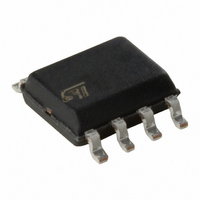TS4890IDT STMicroelectronics, TS4890IDT Datasheet - Page 29

TS4890IDT
Manufacturer Part Number
TS4890IDT
Description
IC AMP AUDIO PWR 1W MONO 8SOIC
Manufacturer
STMicroelectronics
Type
Class ABr
Datasheet
1.TS4890ID.pdf
(32 pages)
Specifications of TS4890IDT
Output Type
1-Channel (Mono)
Max Output Power X Channels @ Load
1W x 1 @ 8 Ohm
Voltage - Supply
2.5 V ~ 5.5 V
Features
Depop, Standby, Thermal Protection
Mounting Type
Surface Mount
Package / Case
8-SOIC (3.9mm Width)
Operational Class
Class-A
Audio Amplifier Output Configuration
1-Channel Mono
Output Power (typ)
1x1@8OhmW
Audio Amplifier Function
Speaker
Total Harmonic Distortion
0.15@8Ohm@250mW%
Single Supply Voltage (typ)
3/5V
Dual Supply Voltage (typ)
Not RequiredV
Supply Current (max)
8@5VmA
Power Supply Requirement
Single
Unity Gain Bandwidth Product (typ)
2MHz
Rail/rail I/o Type
Rail to Rail Output
Power Supply Rejection Ratio
77dB
Single Supply Voltage (min)
2.2V
Single Supply Voltage (max)
5.5V
Dual Supply Voltage (min)
Not RequiredV
Dual Supply Voltage (max)
Not RequiredV
Operating Temp Range
-40C to 85C
Operating Temperature Classification
Industrial
Mounting
Surface Mount
Pin Count
8
Package Type
SOIC
For Use With
497-6363 - BOARD DEMO FOR TS489
Lead Free Status / RoHS Status
Lead free / RoHS Compliant
Available stocks
Company
Part Number
Manufacturer
Quantity
Price
Part Number:
TS4890IDT
Manufacturer:
ST
Quantity:
20 000
We have finished a design and we have chosen for
the components :
• Rin=Rfeed=22k
• Cin=100nF
• Cb=1µF
Now, on fig. 16, we can see the PSRR (input
grounded) vs frequency curves. At 217Hz, we
have a PSRR value of -36dB.
In reality we want a value about -70dB. So, we
need a gain of 34dB !
Now, on fig. 15 we can see the effect of Cb on the
PSRR (input grounded) vs. frequency. With
Cb=100µF, we can reach the -70dB value.
The process to obtain the final curve (Cb=100µF,
Cin=100nF, Rin=Rfeed=22k ) is a simple transfer
point by point on each frequency of the curve on
fig. 16 to the curve on fig. 15.
The measurement result is shown on the next
figure.
Fig. 107 : PSRR changes with Cb
What is the PSRR ?
The PSRR is the Power Supply Rejection Ratio.
It's a kind of SVR in a determined frequency range.
The PSRR of a device, is the ratio between a
power supply disturbance and the result on the
output. We can say that the PSRR is the ability of
a device to minimize the impact of power supply
disturbances to the output.
Note on how to use the PSRR curves
(page 8)
Note on PSRR measurement
-30
-40
-50
-60
-70
10
Cin=100nF
Cb=1 F
100
Cin=100nF
Cb=100 F
Frequency (Hz)
Vcc = 5 & 2.2V
Rfeed = 22k, Rin = 22k
Rg = 100 , RL = 8
Tamb = 25 C
1000
10000
100000
How do we measure the PSRR ?
Fig. 108 : PSRR measurement schematic
• We fixed the DC voltage supply (Vcc)
• We fixed the AC sinusoidal ripple voltage
(Vripple)
• No bypass capacitor Cs is used
The PSRR value for each frequency is :
Remark : The measure of the Rms voltage is not a
Rms selective measure but a full range (2 Hz to
125 kHz) Rms measure. It means that we
measure the effective Rms signal + the noise.
Principle of operation
PSRR
(
dB
)
20
Log
10
Rms
Rms
(
Vs
V (
ripple
Vs
TS4890
)
)
29/32













